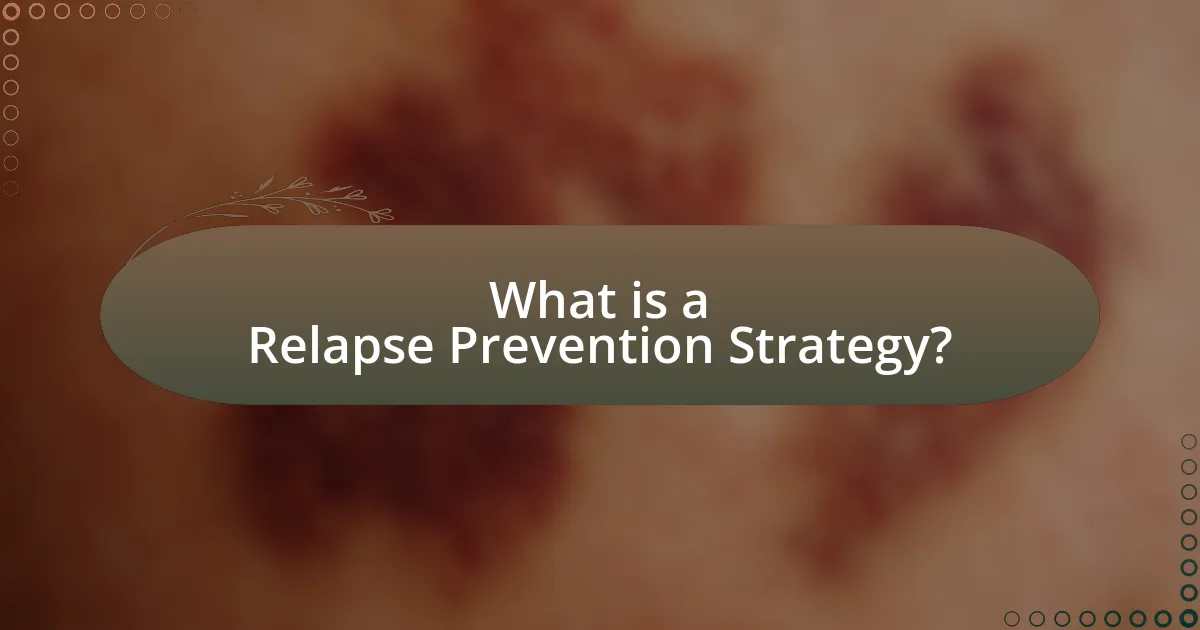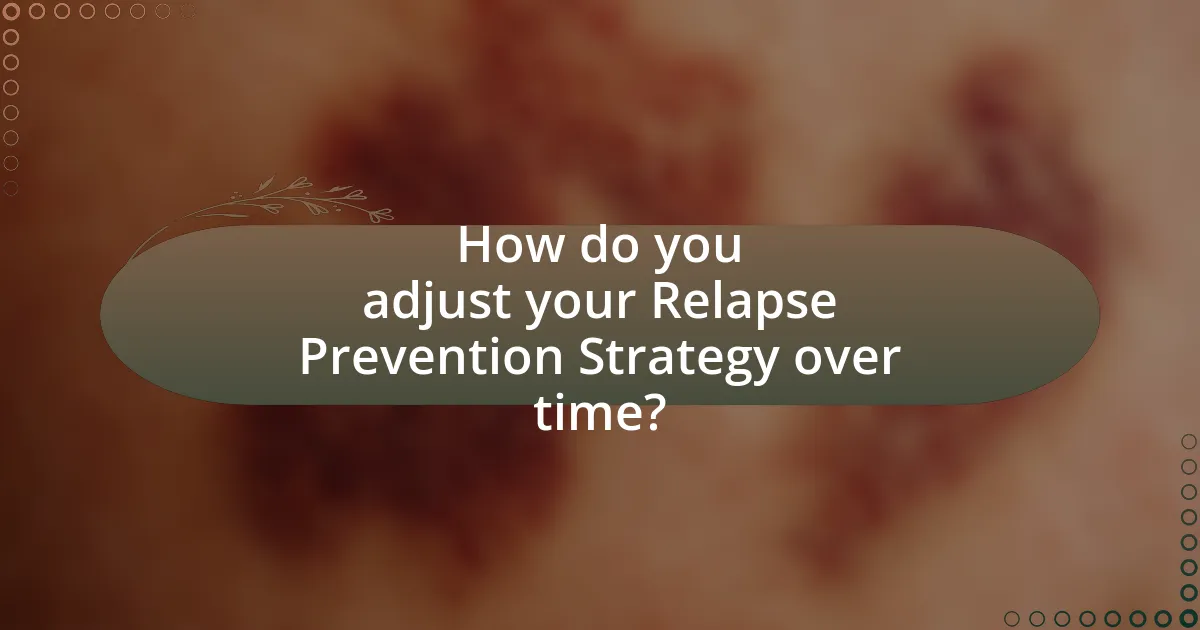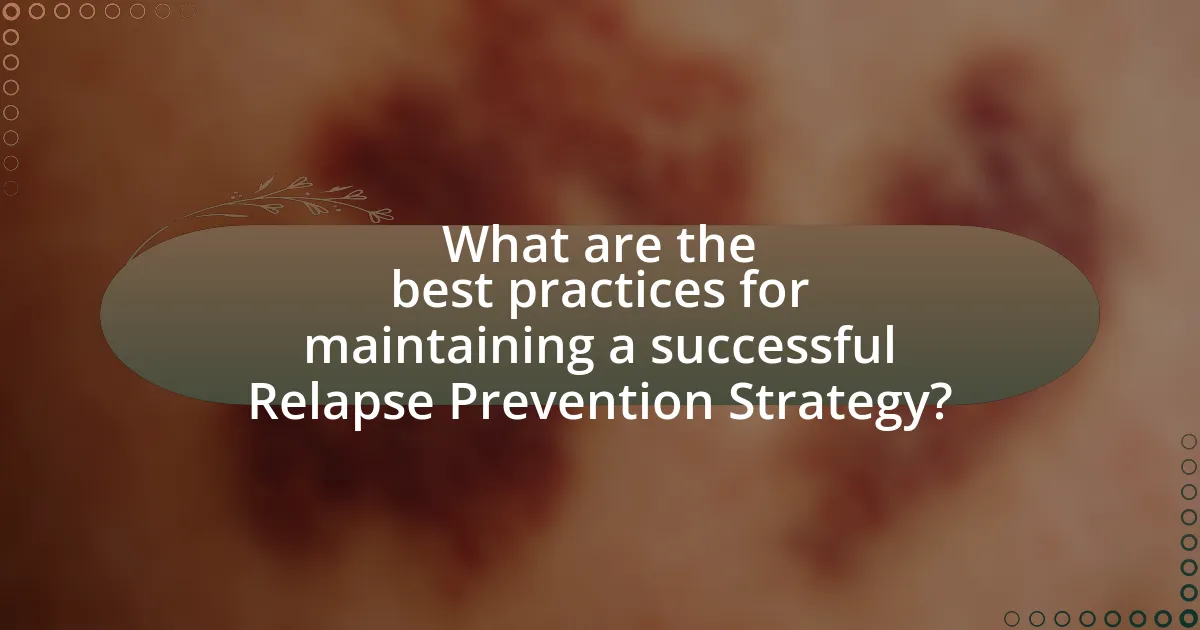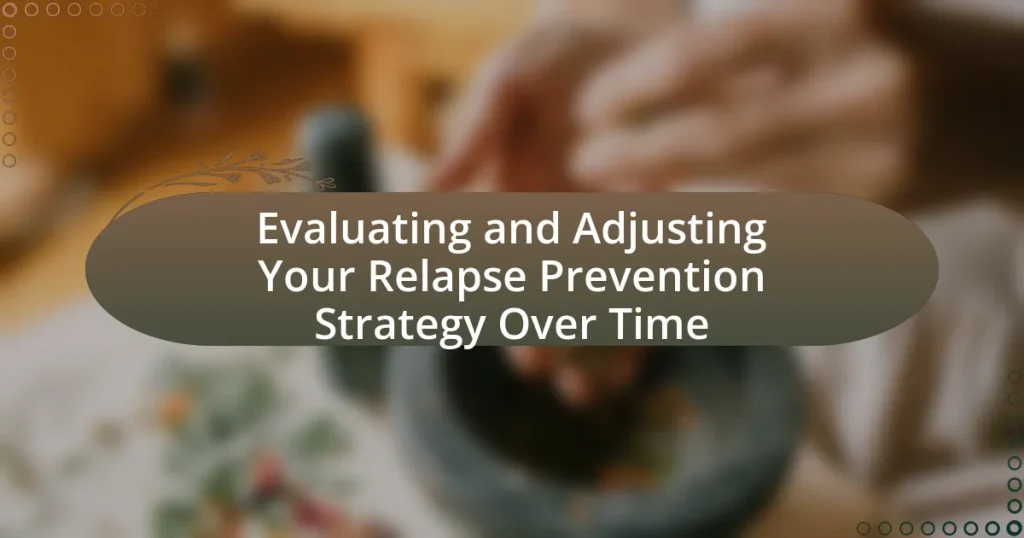A relapse prevention strategy is a structured plan aimed at helping individuals maintain recovery from addiction by identifying triggers and developing coping mechanisms. This article evaluates the importance of such strategies, highlighting their key components, including self-awareness, support systems, and ongoing evaluation. It also discusses how to assess the effectiveness of a strategy, common challenges faced during implementation, and best practices for maintaining success. Additionally, the article emphasizes the role of feedback and resources available to support individuals in refining their relapse prevention efforts over time.

What is a Relapse Prevention Strategy?
A relapse prevention strategy is a structured plan designed to help individuals maintain their recovery from addiction or behavioral issues by identifying triggers and developing coping mechanisms. This strategy typically includes recognizing high-risk situations, employing skills to manage cravings, and establishing a support system to prevent relapse. Research indicates that effective relapse prevention strategies can significantly reduce the likelihood of returning to substance use, as evidenced by studies showing that individuals who actively engage in such strategies have lower relapse rates compared to those who do not.
Why is a Relapse Prevention Strategy important for recovery?
A Relapse Prevention Strategy is crucial for recovery because it equips individuals with the tools and techniques necessary to identify and manage triggers that could lead to relapse. This proactive approach helps maintain long-term sobriety by fostering self-awareness and coping skills. Research indicates that individuals who utilize structured relapse prevention strategies are significantly less likely to relapse; for instance, a study published in the Journal of Substance Abuse Treatment found that participants who engaged in relapse prevention planning had a 50% lower rate of relapse compared to those who did not. By systematically evaluating and adjusting these strategies over time, individuals can adapt to changing circumstances and reinforce their commitment to recovery.
What are the key components of an effective Relapse Prevention Strategy?
An effective Relapse Prevention Strategy includes self-awareness, coping strategies, support systems, and ongoing evaluation. Self-awareness involves recognizing triggers and high-risk situations that may lead to relapse, which is essential for proactive management. Coping strategies provide individuals with tools to handle cravings and stress, such as mindfulness techniques or distraction methods. Support systems, including therapy, support groups, or trusted friends and family, offer emotional and practical assistance during challenging times. Ongoing evaluation ensures that the strategy remains relevant and effective, allowing for adjustments based on personal experiences and changing circumstances. Research indicates that individuals who actively engage in these components have a significantly lower relapse rate, highlighting the importance of a comprehensive approach to prevention.
How does a Relapse Prevention Strategy differ from other recovery plans?
A Relapse Prevention Strategy specifically focuses on identifying triggers and developing coping mechanisms to prevent relapse, distinguishing it from other recovery plans that may not emphasize these proactive measures. Unlike general recovery plans, which often outline broader goals and steps for sobriety, a Relapse Prevention Strategy is tailored to anticipate and manage high-risk situations, thereby enhancing the individual’s ability to maintain long-term recovery. Research indicates that targeted strategies, such as those outlined in the Relapse Prevention Model by Marlatt and Donovan, significantly reduce the likelihood of relapse by equipping individuals with specific skills to handle cravings and stressors effectively.
How can you assess the effectiveness of your current Relapse Prevention Strategy?
To assess the effectiveness of your current Relapse Prevention Strategy, you should track relapse rates and analyze triggers and coping mechanisms. Monitoring the frequency of relapses over a specific period provides quantitative data on the strategy’s success. Additionally, conducting regular self-assessments or utilizing standardized tools, such as the Substance Abuse Subtle Screening Inventory (SASSI), can help identify areas needing improvement. Research indicates that individuals who actively engage in self-monitoring and reflection are more likely to maintain long-term recovery, as evidenced by a study published in the Journal of Substance Abuse Treatment, which found that structured follow-ups significantly reduced relapse rates.
What metrics can be used to evaluate the success of a Relapse Prevention Strategy?
Metrics used to evaluate the success of a Relapse Prevention Strategy include the rate of relapse, duration of sobriety, and frequency of high-risk situations encountered. The rate of relapse quantifies the percentage of individuals who return to substance use after a period of sobriety, providing a direct measure of strategy effectiveness. Duration of sobriety tracks the length of time individuals maintain abstinence, indicating the sustainability of the prevention efforts. Frequency of high-risk situations assesses how often individuals face triggers or environments that could lead to relapse, helping to identify areas for improvement in the strategy. These metrics collectively offer a comprehensive view of the strategy’s impact on preventing relapse.
How often should you review your Relapse Prevention Strategy?
You should review your Relapse Prevention Strategy at least once a month. Regular monthly reviews allow individuals to assess their progress, identify triggers, and make necessary adjustments to their strategies. Research indicates that consistent evaluation enhances the effectiveness of prevention strategies, as it enables timely modifications based on personal experiences and changing circumstances.
What common challenges arise when implementing a Relapse Prevention Strategy?
Common challenges when implementing a Relapse Prevention Strategy include lack of commitment from individuals, insufficient support systems, and difficulty in identifying triggers. Individuals may struggle to maintain motivation, which can hinder adherence to the strategy. Research indicates that social support significantly impacts recovery outcomes; without a robust support network, individuals may feel isolated and more prone to relapse. Additionally, accurately recognizing and managing triggers can be complex, as they often vary over time and can be influenced by external factors, making it challenging to develop effective coping mechanisms.
How can triggers impact the effectiveness of your strategy?
Triggers can significantly impact the effectiveness of your relapse prevention strategy by influencing emotional and behavioral responses. When individuals encounter specific triggers, such as stress or environmental cues, they may experience cravings or urges that can lead to relapse, undermining the strategy’s success. Research indicates that identifying and managing these triggers is crucial; for instance, a study published in the Journal of Substance Abuse Treatment found that individuals who effectively recognized and avoided triggers had a 30% higher success rate in maintaining sobriety over six months compared to those who did not. Thus, understanding and addressing triggers is essential for enhancing the overall effectiveness of a relapse prevention strategy.
What role does support from others play in maintaining your strategy?
Support from others is crucial in maintaining a relapse prevention strategy as it provides accountability, encouragement, and emotional reinforcement. When individuals have a support system, such as friends, family, or support groups, they are more likely to adhere to their strategies and make necessary adjustments. Research indicates that social support can significantly reduce the likelihood of relapse; for instance, a study published in the Journal of Substance Abuse Treatment found that individuals with strong social networks had a 50% lower risk of relapse compared to those without such support. This demonstrates that the presence of supportive relationships enhances commitment to the strategy and fosters resilience against potential setbacks.

How do you adjust your Relapse Prevention Strategy over time?
To adjust your Relapse Prevention Strategy over time, regularly assess triggers and coping mechanisms to ensure they remain effective. This involves monitoring personal experiences and identifying any new stressors or situations that may lead to relapse. Research indicates that ongoing evaluation and modification of strategies can significantly reduce the risk of relapse, as evidenced by studies showing that individuals who adapt their prevention plans based on changing circumstances have higher success rates in maintaining recovery.
What signs indicate that your Relapse Prevention Strategy needs adjustment?
Signs that indicate your Relapse Prevention Strategy needs adjustment include increased cravings, frequent thoughts of using substances, and a return to old behaviors or triggers. These signs suggest that the current strategy is not effectively managing risks. For instance, research shows that individuals who report heightened cravings are at a greater risk of relapse, indicating a need for reevaluation of coping mechanisms and support systems. Additionally, if a person finds themselves in situations that lead to temptation more often, it signals that environmental factors may not be adequately addressed in the strategy.
How can you identify ineffective components of your strategy?
To identify ineffective components of your strategy, conduct a thorough analysis of performance metrics and feedback mechanisms. Regularly review key performance indicators (KPIs) related to your strategy’s objectives, such as success rates, engagement levels, and user satisfaction. For instance, if a specific intervention shows a low success rate in preventing relapse, it indicates that this component may be ineffective. Additionally, gather qualitative feedback from participants to understand their experiences and challenges, which can highlight areas needing improvement. This data-driven approach ensures that decisions are based on concrete evidence, allowing for targeted adjustments to enhance overall effectiveness.
What steps should you take to modify your strategy effectively?
To modify your strategy effectively, first assess the current effectiveness of your relapse prevention strategy by analyzing data on past relapses and triggers. This assessment should include identifying patterns and specific situations that led to relapses, which can be supported by research indicating that understanding triggers is crucial for effective prevention (Marlatt & Donovan, 2005). Next, gather feedback from support networks or professionals to gain insights into potential areas for improvement. After gathering this information, adjust your strategy by incorporating new coping mechanisms or support systems that address identified weaknesses. Finally, implement the modified strategy and continuously monitor its effectiveness, making further adjustments as necessary based on ongoing evaluations. This iterative process is essential for maintaining a robust relapse prevention strategy over time.
How can feedback from peers and professionals enhance your strategy?
Feedback from peers and professionals can significantly enhance your strategy by providing diverse perspectives and expert insights. Peers can share personal experiences and practical tips that may not be evident in theoretical frameworks, while professionals can offer evidence-based strategies and identify potential pitfalls. Research indicates that collaborative feedback mechanisms improve decision-making and strategy effectiveness, as seen in studies like “The Role of Peer Feedback in Enhancing Learning Outcomes” published in the Journal of Educational Psychology, which found that peer feedback led to a 20% increase in performance metrics. This combination of experiential and expert feedback fosters a more comprehensive understanding of challenges and solutions, ultimately leading to a more robust and adaptable relapse prevention strategy.
What types of feedback are most valuable for improving your strategy?
The most valuable types of feedback for improving your strategy include quantitative data, qualitative insights, and peer reviews. Quantitative data, such as performance metrics and success rates, provide measurable evidence of what is working and what is not, allowing for data-driven adjustments. Qualitative insights, gathered through surveys or interviews, offer personal perspectives that can highlight areas needing attention or improvement. Peer reviews, where colleagues assess each other’s strategies, foster accountability and can reveal blind spots that may not be apparent to the individual. These feedback types collectively enhance the effectiveness of a relapse prevention strategy by ensuring it is both evidence-based and responsive to individual needs.
How can you incorporate feedback into your ongoing adjustments?
Incorporating feedback into ongoing adjustments involves systematically analyzing the feedback received and integrating it into your strategy. This can be achieved by regularly reviewing feedback from various sources, such as self-assessments, peer evaluations, or professional guidance, and identifying patterns or recurring themes that indicate areas for improvement. For instance, if feedback highlights a specific trigger that leads to relapse, adjustments can be made to develop coping strategies tailored to that trigger. Research indicates that continuous feedback loops enhance the effectiveness of behavioral strategies, as demonstrated in studies on cognitive-behavioral therapy, which emphasize the importance of adapting interventions based on client feedback to improve outcomes.

What are the best practices for maintaining a successful Relapse Prevention Strategy?
The best practices for maintaining a successful Relapse Prevention Strategy include regular self-assessment, developing a strong support network, and utilizing coping strategies. Regular self-assessment allows individuals to identify triggers and high-risk situations, enabling proactive adjustments to their strategies. A strong support network, consisting of friends, family, or support groups, provides emotional reinforcement and accountability, which are crucial for long-term success. Utilizing coping strategies, such as mindfulness techniques or stress management practices, equips individuals with tools to handle cravings and stressors effectively. Research indicates that individuals who actively engage in these practices are less likely to relapse, as they foster resilience and adaptability in the face of challenges.
How can you create a sustainable routine to support your strategy?
To create a sustainable routine that supports your relapse prevention strategy, establish consistent daily practices that align with your goals. This involves setting specific times for activities such as exercise, mindfulness, and self-reflection, which have been shown to enhance emotional regulation and reduce the likelihood of relapse. Research indicates that structured routines can improve adherence to recovery plans, as evidenced by a study published in the Journal of Substance Abuse Treatment, which found that individuals with regular schedules reported lower relapse rates. By integrating these practices into your daily life, you reinforce your commitment to your strategy and create a supportive environment for long-term recovery.
What daily habits can reinforce your Relapse Prevention Strategy?
Daily habits that can reinforce your Relapse Prevention Strategy include maintaining a structured routine, practicing mindfulness, engaging in regular physical activity, and seeking social support. A structured routine helps create stability and predictability, reducing the likelihood of triggers. Mindfulness practices, such as meditation or deep breathing, enhance self-awareness and emotional regulation, which are crucial for recognizing and managing cravings. Regular physical activity has been shown to improve mood and reduce stress, both of which can lower the risk of relapse. Additionally, seeking social support through friends, family, or support groups provides accountability and encouragement, which are essential for long-term recovery. Research indicates that individuals who actively engage in these daily habits report lower relapse rates and improved overall well-being.
How can mindfulness and self-awareness contribute to your success?
Mindfulness and self-awareness significantly contribute to success by enhancing emotional regulation and decision-making. Practicing mindfulness allows individuals to remain present and focused, reducing stress and improving clarity in thought processes. Self-awareness enables individuals to recognize their strengths and weaknesses, facilitating better goal setting and personal growth. Research indicates that mindfulness practices can lead to increased resilience and improved performance in various domains, including work and personal relationships. For instance, a study published in the Journal of Occupational Health Psychology found that mindfulness training improved employees’ job performance and reduced burnout. This evidence underscores the importance of mindfulness and self-awareness as critical components in achieving sustained success.
What resources are available to support your Relapse Prevention efforts?
Resources available to support relapse prevention efforts include support groups, therapy, educational materials, and mobile applications. Support groups, such as Alcoholics Anonymous and SMART Recovery, provide community and shared experiences, which are crucial for maintaining sobriety. Therapy options, including cognitive-behavioral therapy (CBT), have been shown to reduce relapse rates by helping individuals develop coping strategies. Educational materials, such as workbooks and online courses, offer insights into triggers and coping mechanisms. Additionally, mobile applications like Sober Grid and I Am Sober provide tools for tracking progress and connecting with others in recovery. These resources collectively enhance the effectiveness of relapse prevention strategies by offering practical support and fostering accountability.
Which books or programs are recommended for further learning?
For further learning on evaluating and adjusting relapse prevention strategies, “The Recovery Book” by Al Mooney, M.D., and “Relapse Prevention: Maintenance Strategies in the Treatment of Addictive Behaviors” by G. Alan Marlatt and Dennis M. Donovan are highly recommended. These books provide evidence-based approaches and practical strategies for maintaining recovery and preventing relapse. Additionally, programs such as SMART Recovery and the 12-Step program offer structured support and resources for individuals seeking to enhance their relapse prevention skills.
How can online communities provide support and accountability?
Online communities provide support and accountability by fostering connections among individuals with shared goals, enabling them to share experiences and offer encouragement. These platforms facilitate regular check-ins and discussions, which help members stay committed to their objectives. Research indicates that social support from peers can significantly enhance motivation and adherence to personal goals, as seen in studies like the one published in the Journal of Health Psychology, which found that individuals participating in online support groups reported higher levels of accountability and success in behavior change.
What practical tips can help you refine your Relapse Prevention Strategy?
To refine your Relapse Prevention Strategy, regularly assess triggers and high-risk situations to identify patterns that may lead to relapse. This involves keeping a detailed journal of thoughts, feelings, and behaviors associated with cravings or urges, which can help in recognizing specific triggers. Additionally, engage in ongoing support through therapy or support groups, as social connections provide accountability and encouragement. Research indicates that individuals who actively participate in support networks have lower relapse rates, reinforcing the importance of community in recovery. Lastly, continuously update coping strategies based on what has been effective or ineffective in the past, ensuring that your approach remains relevant to your current circumstances.
